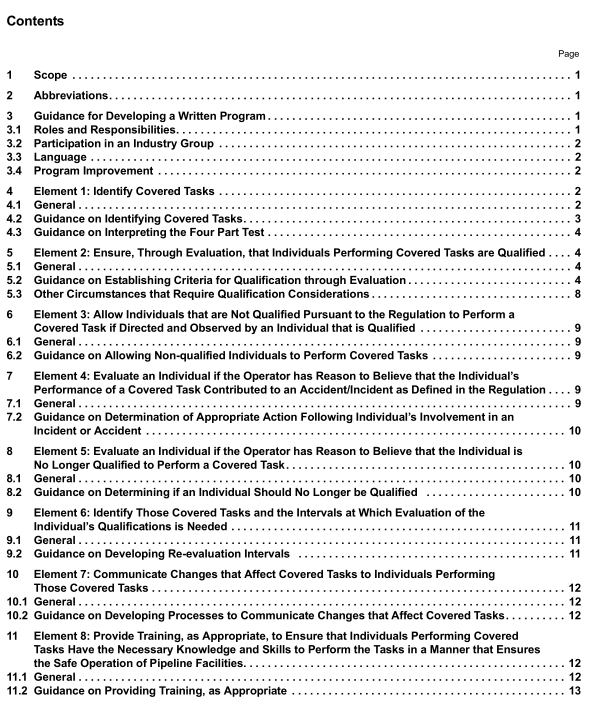API RP 1161 pdf download

API RP 1161 pdf download Recommended Practice for Pipeline Operator Qualification (OQ)
—is performed as a requirement of 49 CFR Part 195, and
-affects the operations or integrity of the pipeline.
The four criteria listed above shall be referred to hereafter as the four-part test.
4.2Guidance on ldentifying Covered Tasks
4.2.1General
In developing the covered task list, the Operator shall consider tasks performed on the pipeline facility, regardless ofwho performs them (employees, contractors,subcontractors,or other entities such as other pipeline Operators orthose with access to the Operator’s equipment).For example, if an Operator contracts out pipeline repair activities,those activities shall be considered in the identification of covered tasks.
The Operator has flexibility to determine how to accomplish covered task identification. The Operator shoulddocument the method and justfication for selecting covered tasks. Options for establishing a covered task list mayinclude but are not limited to the following two methods.
4.2.2Adoption of an Industry-Developed Covered Task List
Industry and technical associations, qualification product providers, and others have developed covered task liststhrough subject matter expert consensus. The Covered Task List developed by APl (in conjuction with the OperatorQualification workgroup under the Pipeline Committee) is attached to this document as Annex A The Operatorshould take additional steps if adopting such a list and at a minimum, should compare the covered task list to itsoperations and maintenance activities in order to ensure completeness. The Operator has the flexibility to combine orseparate covered tasks as suitable to its operations and, if gaps are identified should apply the four-part test to add ordelete covered tasks as applicable.
4.2.3Analysis of Operations and Maintenance Activities
An analysis of operations and maintenance activities may be used in the process of determining which activitiesshould be included in an Operator’s covered task list.ltems to be considered when conducting activity identificationand analysis may include, but are not limited to the following:
-CFR Part 195;
state or local requirements;
operations, maintenance and safety procedures;
industry developed covered task list(s);
– applicable Pipeline and Hazardous Materials Safety Administration(PHMSA)Advisory Bulletins.
lt may be helpful to record each applicable activity on a master list, and document the answers to the four-part testquestions, adding justification notes as needed.This method of documentation will produce a list of covered and non-covered tasks and may assist in regulatory and internal reviews.Subject matter experts,regulatory compliancepersonnel, and others may be enlisted to assist in the identification and analysis of activities. Operators have theflexibility to include additional tasks that do not meet the four-part test.
4.3Guidance on Interpreting the Four Part Test4.3.1 Part 1—ls the Task Performed on a Pipeline Facility?
Operators should review the regulatory definitions of pipeline and pipeline facility.Components,piping,andequipment that are physically connected to the pipeline or pipeline system (i.e. by wires,tubing. pipe, or by thepipeline right of way) or that are connected by signals through the air are considered part of the pipeline facility.
A component, piping, or equipment disconnected and physically removed from the pipeline or pipeline system is notconsidered part of the pipeline facility.A component that is disconnected, but not physically removed from the pipelinefacility, would meet the requirement of Part 1 of the four-part test.
4.3.2Part 2—ls the Task an Operations or Maintenance Task?
Operations tasks may be defined as those activities associated with monitoring and controlling the transportation ofhazardous materials within a pipeline system. Maintenance tasks may be defined as those activities performed tomaintain, restore, replace, or relocate existing pipeline facilities.
4.3.3 Part 3—ls the Task Performed as a Requirement of 49 CFR Part 195?
The Operator should review all Subparts of 195,applicable PHMSA Advisory Bulletins, and state and localrequirements to ensure completeness of all tasks. Operations and maintenance tasks are not limited to those tasksaddressed in 195 Subpart F.
4.3.4 Part 4—Does the Task Affect the Operation or lntegrity of the Pipeline?
Operators shall consider tasks that, if performed incorrectly, could adversely affect the operations or integrity of thepipeline,during or after the performance of the task.Operations include actions taken to facilitate storage ormovement of product through a regulated pipeline.The integrity of the pipeline refers to the pipeline’s ability tooperate safely and to withstand the stresses imposed during operations.
5 Element 2: Ensure,Through Evaluation, that Individuals Performing Covered Tasks are
Qualified
5.1General
As defined in the regulation, qualified means that an individual has been evaluated and can:(a) perform assignedcovered tasks and (b) recognize and react to abnormal operating conditions associated with those tasks.
5.2Guidance on Establishing Criteria for Qualification through Evaluation
5.2.1General
The terms qualification and evaluation are frequently used interchangeably throughout the industry; however, they aretwo distinct terms.
Qualification is the result of a process determined by the Operator that includes successful completion of task specficevaluation(s) with the associated AOCs, documentation and any other requirements as documented in the programwhereas an evaluation is a step in the qualification process.









